Understanding Threats to Young Children’s Green Space Access in Unlicensed Daycare Centers in Japan
Abstract
1. Introduction
- (1)
- What is the role of UDCs in providing children with access to green space?
- (a)
- What are the practices of UDCs in providing green space access?
- (b)
- What is UDC caregivers’ perception of the role of green space for children’s development?
- (c)
- What is the UDCs willingness to pay for access to green space?
- (d)
- What factors influence UDCs provision of green space access?
- (2)
- What is the role of parents for children’s access to green space during daycare?
- (a)
- What factors influence parents’ choice of daycare?
- (b)
- What is parents’ perception of children’s access to green space?
- (c)
- What is parents’ willingness to pay for access to green space?
- (d)
- What factors influence parents’ attitude towards green space access?
- (3)
- What are the implications for policy and stakeholders?
2. Materials and Methods
2.1. Study Sites
2.2. Data Collection, Survey Instruments and Data Analysis
2.2.1. Survey of Unlicensed Daycare Centers (UDCs)
2.2.2. Survey of Parents with Children in Daycare
2.2.3. Data Analysis
3. Results
3.1. Unlicensed Daycare Centers’ Perspective on Children’s Access to Greenspace
3.1.1. Sample Characteristics
3.1.2. UDC’s Practices in Providing GS Access
3.1.3. Caregivers’ Perception of the Role of Greenspace for Children & Capacity of Existing Greenspace to Fulfill this Role
3.1.4. UDCs Willingness to Pay for Access to Greenspace
3.1.5. Factors Influencing UDCs Provision of Greenspace Access
3.2. Parents Perspectives on Children’s Access to Greenspace
3.2.1. Sample Characteristics and Choice of Daycare
3.2.2. Parents’ Reasons for Daycare Choice and Influencing Factors
3.2.3. Parents’ Perception of Children’s Access to Greenspace
3.2.4. Parents’ Willingness to Pay for Children’s Access to Greenspace during Daycare
3.2.5. Factors Associated with Parents’ Attitude towards Greenspace Access
4. Discussion
4.1. Caregivers as Mediators: Potential and Limits of UDCs for Providing Children’s Access to Greenspace
4.2. The Role of Parents for Children’s Access to Greenspace
4.3. Implications for Stakeholders, Public Health, and Urban Planning
4.3.1. Implications for Daycare Centers and Parents as Stakeholders
4.3.2. Implications for Public Health
4.3.3. Implications for Urban Planning
4.4. Limitations of the Study
5. Conclusions
Supplementary Materials
Author Contributions
Funding
Acknowledgments
Conflicts of Interest
References
- Palley, H.A.; Usui, C. Child daycare policy in Japan: An examination of the program and its impacts. J. Comp. Soc. Welf. 2008, 24, 165–178. [Google Scholar] [CrossRef]
- Keniger, L.; Gaston, K.; Irvine, K.; Fuller, R. What are the benefits of interacting with nature? Int. J. Environ. Res. Public Health 2013, 10, 913–935. [Google Scholar] [CrossRef]
- Chawla, L. Benefits of nature contact for children. J. Plan. Lit. 2015, 30, 433–452. [Google Scholar] [CrossRef]
- Cheng, J.C.-H.; Monroe, M.C. Connection to nature: Children’s affective attitude toward nature. Environ. Behav. 2012, 44, 31–49. [Google Scholar] [CrossRef]
- Moore, R.C. The need for nature: A childhood right. Soc. Justice 1997, 24, 203–220. [Google Scholar]
- Maller, C.J. Promoting children’s mental, emotional and social health through contact with nature: A model. Health Educ. 2009, 109, 522–543. [Google Scholar] [CrossRef]
- Wolch, J.; Jerrett, M.; Reynolds, K.; McConnell, R.; Chang, R.; Dahmann, N.; Brady, K.; Gilliland, F.; Su, J.G.; Berhane, K. Childhood obesity and proximity to urban parks and recreational resources: A longitudinal cohort study. Health Place 2011, 17, 207–214. [Google Scholar] [CrossRef] [PubMed]
- Soga, M.; Gaston, K.J. Extinction of experience: The loss of human-nature interactions. Front. Ecol. Environ. 2016, 14, 94–101. [Google Scholar] [CrossRef]
- Clements, R. An investigation of the status of outdoor play. Contemp. Issues Early Child. 2004, 5, 68–80. [Google Scholar] [CrossRef]
- Fukaya, M. Kodomotachi no asobi. Monogr. Shōgakusei Nau 1999, 19, 5–90. Available online: https://berd.benesse.jp/shotouchutou/research/detail1.php?id=3354 (accessed on 15 March 2020).
- Soga, M.; Gaston, K.J.; Kubo, T. Cross-generational decline in childhood experiences of neighborhood flowering plants in Japan. Landsc. Urban Plan. 2018, 174, 55–62. [Google Scholar] [CrossRef]
- Soga, M.; Yamanoi, T.; Tsuchiya, K.; Koyanagi, T.F.; Kanai, T. What are the drivers of and barriers to children’s direct experiences of nature? Landsc. Urban Plan. 2018, 180, 114–120. [Google Scholar] [CrossRef]
- Louv, R. Last Child in the Woods: Saving Our Children from Nature-Deficit Disorder; Algonquin Books: Chapel Hill, NC, USA, 2008; ISBN 978-1-56512-586-5. [Google Scholar]
- Kuo, F.E. “Ming” nature-deficit disorder: Evidence, dosage, and treatment. J. Policy Res. Tour. Leis. Events 2013, 5, 172–186. [Google Scholar]
- Dickinson, E. The misdiagnosis: Rethinking “nature-deficit disorder”. Environ. Commun. 2013, 7, 315–335. [Google Scholar] [CrossRef]
- Rupprecht, C.D.D.; Byrne, J.A.; Lo, A.Y.H. Memories of vacant lots: How and why residents used informal urban greenspace as children and teenagers in Brisbane, Australia and Sapporo, Japan. Child. Geogr. 2016, 14, 340–355. [Google Scholar] [CrossRef]
- Cloke, P.; Jones, O. ‘Unclaimed territory’: Childhood and disordered space(s). Soc. Cult. Geogr. 2005, 6, 311–333. [Google Scholar] [CrossRef]
- Mugford, K. Nature, nurture; danger, adventure; junkyard, paradise; the role of wildscapes in children’s literature. In Urban Wildscapes; Jorgensen, A., Keenan, R., Eds.; Routledge: Abingdon, UK, 2012; pp. 80–96. ISBN 978-0-415-58106-6. [Google Scholar]
- Shpancer, N. Caregiver–parent relationships in daycare: A review and re-examination of the data and their implications. Early Educ. Dev. 1998, 9, 239–259. [Google Scholar] [CrossRef]
- Misra, J. Caring about care. Fem. Stud. 2003, 29, 387–401. [Google Scholar]
- Hochschild, A.R. The Commercialization of Intimate Life: Notes from Home and Work; University of California Press: Berkeley, CA, USA, 2003; ISBN 978-0-520-21488-0. [Google Scholar]
- Hochschild, A.R. The Outsourced Self: Intimate Life in Market Times; Henry Holt and Company: New York, NY, USA, 2012; ISBN 978-0-8050-8889-2. [Google Scholar]
- Epp, A.M.; Velagaleti, S.R. Outsourcing parenthood? How families manage care assemblages using paid commercial services. J. Consum. Res. 2014, 41, 911–935. [Google Scholar] [CrossRef]
- Uno, K.S. Passages to Modernity: Motherhood, Childhood, and Social Reform in Early Twentieth Century Japan; University of Hawaii Press: Honolulu, HI, USA, 1999; ISBN 978-0-8248-2137-1. [Google Scholar]
- Rupprecht, C.D.D. Informal urban green space: Residents’ perception, use, and management preferences across four major Japanese shrinking cities. Land 2017, 6, 59. [Google Scholar] [CrossRef]
- Statistics Bureau of Japan. Population Aged 15 Years Old and Over by Labour Force Status. Available online: https://www.stat.go.jp/data/roudou/longtime/03roudou.html#hyo_1 (accessed on 13 February 2020).
- Osaki, T. Angry blog post sparks movement for improved day care. The Japan Times, 7 March 2016. Available online: https://www.japantimes.co.jp/news/2016/03/07/national/angry-blog-post-sparks-movement-for-improved-day-care/ (accessed on 15 March 2020).
- Lack of nursery school spots still widespread a year after “Die Japan!” blog post. The Japan Times, 10 February 2017. Available online: https://www.japantimes.co.jp/news/2017/02/09/national/social-issues/lack-nursery-school-spots-still-widespread-year-die-japan-blog-post/ (accessed on 15 March 2020).
- Takaku, R. The wall for mothers with first graders: Availability of afterschool childcare and continuity of maternal labor supply in Japan. Rev. Econ. Househ. 2019, 17, 177–199. [Google Scholar] [CrossRef]
- Holthus, B. Infrastructural family policy in Japan: Parental evaluation. In Family Life in Japan and Germany: Challenges for a Gender-Sensitive Family Policy; Meier-Gräwe, U., Motozawa, M., Schad-Seifert, A., Eds.; Springer Fachmedien: Wiesbaden, Germany, 2019; pp. 135–156. ISBN 978-3-658-26638-7. [Google Scholar]
- Cooke, F.L.; Jiang, Y. The growth of non-standard employment in Japan and South Korea: The role of institutional actors and impact on workers and the labour market. Asia Pac. J. Hum. Resour. 2017, 55, 155–176. [Google Scholar] [CrossRef]
- Johnston, E. Is Japan becoming extinct? The Japan Times, 16 May 2015. Available online: https://www.japantimes.co.jp/news/2015/05/16/national/social-issues/japan-becoming-extinct/ (accessed on 15 March 2020).
- Wakabayashi, Y.; Kukimoto, M.; Yui, Y. The role of unlicensed childcare facilities in providing childcare services in Naha City, Okinawa. Ann. Assoc. Econ. Geogr. 2012, 58, 79–99. [Google Scholar]
- Yamada, A.; Fujita, D. Hoikushisetu (Kenchikusekkei Tekisuto); Shōkokusha: Tokyo, Japan, 2017; ISBN 978-4-395-32088-2. [Google Scholar]
- “Kodomo Hashiru to Shiba Itamu” Hokudai ga Tachiiri Kisei Yōchien Konwaku; Hokkaido Shimbun Press: Hokkaido, Japan, 2016; Available online: https://web.archive.org/web/20161006121015/http://dd.hokkaido-np.co.jp/news/area/sapporo/1-0324046.html (accessed on 15 March 2020).
- Shiino, A. A case study on selective usage of urban parks by child-care facilities. J. Jpn. Inst. Landsc. Archit. 2007, 70, 637–642. [Google Scholar] [CrossRef][Green Version]
- Shiino, A. A Study of chirdren’s demands of urban park facilities according to their drawings. JILA Annu. Sci. Res. Meet. Abstr. 2009, 2009, 65. [Google Scholar]
- Koike, T.; Sadayuki, M. A study on outdoor environments for day nurseries in Tokyo for the environmental improvement of child care facilities. J Arch. Plann 2008, 73, 1197–1204. [Google Scholar] [CrossRef]
- Koike, T.; Sadayuki, M.; Nojima, K. A study of the ideal standards in the physical environments of day nurseries through a comparison with Germany and Sweden. Mem. Jpn. Womens Univ. Fac. Home Econ. 2013, 60, 61–67. [Google Scholar]
- Miwa, N.; Tanaka, I.; Matsuhashi, K.; Taniguchi, S.; Tanimura, A. Research on substitutive use of park for outdoor activities to day nursery. J. City Plan. Inst. Jpn. 2008, 43.3, 907–912. [Google Scholar]
- Tanaka, I.; Miwa, N.; Matsuhashi, K.; Taniguchi, S. Utilization and evaluation of block park for outdoor activities of day nurseries near the railway stations in Yokohama. J. City Plan. Inst. Jpn. 2009, 44.3, 373–378. [Google Scholar]
- Matsuhashi, K.; Miwa, N.; Tanaka, I.; Taniguchi, S.; Ohara, K.; Fujioka, Y. A study on regional resources utilized by day nurseries from the view point of outdoor activity space and activities in the child-care facilities. J. Archit. Plan. Trans. AIJ 2010, 75, 1017–1024. [Google Scholar] [CrossRef]
- Yamada, A.; Satoh, E.; Sanuki, R. A study on the evaluation of urban environment as child nurturing environment by staff of small bases for child-care. J. City Plan. Inst. Jpn. 2009, 44.3, 175–180. [Google Scholar] [CrossRef][Green Version]
- Miyaji, S.; Ichimura, K.; Kanaoka, S. The current state of child care support services utilizing the urban parks. J. Jpn. Inst. Landsc. Archit. 2017, 80, 627–630. [Google Scholar] [CrossRef]
- Shiino, A. Investigation of the methodology of reevaluating small-scale urban parks from the viewpoint of nursery school’s usage. J. Jpn. Inst. Landsc. Archit. 2017, 80, 489–492. [Google Scholar] [CrossRef]
- Shiino, A. Analysis of the relationships between nursery schools’ urban park usages as out of school activities and their infants’ attributes. J. Jpn. Inst. Landsc. Archit. 2019, 82, 487–492. [Google Scholar] [CrossRef]
- Miyaji, S.; Kanaoka, S.; Komatsu, A.; Ichimura, K. A study on changing consciousness of users by child care support service in urban parks to contribute regional creation. J. Jpn. Inst. Landsc. Archit. 2019, 82, 511–516. [Google Scholar] [CrossRef][Green Version]
- National Institute of Population and Social Security. Research Regional Population Projections for Japan: 2015–2045 (2018)|National Institute of Population and Social Security Research. Available online: http://www.ipss.go.jp/pp-shicyoson/e/shicyoson18/t-page.asp (accessed on 13 February 2020).
- Statistics Bureau of Japan National Census 2015. Available online: https://www.e-stat.go.jp/stat-search/files?page=1&layout=datalist&toukei=00200521&tstat=000001080615&cycle=0&tclass1=000001089055&tclass2=000001089056&stat_infid=000031473210 (accessed on 14 February 2020).
- Ministry of Health, Labour and Welfare. Current Status of Non-Authorized Childcare Facilities. Available online: https://www.mhlw.go.jp/stf/houdou/0000159036_00001.html (accessed on 14 February 2020).
- Ministry of Land, Infrastructure, Transport and Tourism. Present Status of Urban Parks, etc. Per Capita by Prefecture. Available online: http://www.mlit.go.jp/crd/park/joho/database/t_kouen/ (accessed on 14 February 2020).
- Field, A.; Miles, J.; Field, Z. Discovering Statistics Using R; SAGE: Thousand Oaks, CA, USA, 2012; ISBN 978-1-4462-5846-0. [Google Scholar]
- The Jamovi Project. Jamovi (Version 0.9.5.3-1.2.5); The Jamovi Project, 2020; Available online: https://www.jamovi.org (accessed on 15 March 2020).
- QGIS Development Team. QGIS Geographic Information System; Open Source Geospatial Foundation: Beaverton, OR, USA, 2019. [Google Scholar]
- Rupprecht, C.D.D.; Byrne, J.A.; Ueda, H.; Lo, A.Y.H. ‘It’s real, not fake like a park’: Residents’ perception and use of informal urban green-space in Brisbane, Australia and Sapporo, Japan. Landsc. Urban Plan. 2015, 143, 205–218. [Google Scholar] [CrossRef]
- Steiner, K.; Krauss, E.S.; Flanagan, S.E. Political Opposition and Local Politics in Japan; Princeton University Press: Princeton, NJ, USA, 2014; ISBN 978-1-4008-5704-3. [Google Scholar]
- Free preschool education raises concerns over run on nurseries. The Japan Times, 8 October 2019. Available online: https://www.japantimes.co.jp/news/2019/10/08/national/politics-diplomacy/free-preschool-education-raises-concerns-run-nurseries/ (accessed on 15 March 2020).
- Jennings, V.; Larson, L.; Yun, J. Advancing sustainability through urban green space: Cultural ecosystem services, equity, and social determinants of health. Int. J. Environ. Res. Public Health 2016, 13, 196. [Google Scholar] [CrossRef]
- White, M.P.; Alcock, I.; Grellier, J.; Wheeler, B.W.; Hartig, T.; Warber, S.L.; Bone, A.; Depledge, M.H.; Fleming, L.E. Spending at least 120 min a week in nature is associated with good health and wellbeing. Sci. Rep. 2019, 9, 1–11. [Google Scholar] [CrossRef]
- Gill, S.E.; Handley, J.F.; Ennos, A.R.; Pauleit, S. Adapting cities for climate change: The role of the green infrastructure. Built Environ. 2007, 33, 115–133. [Google Scholar] [CrossRef]
- Kim, M.; Rupprecht, C.; Furuya, K.; Kim, M.; Rupprecht, C.D.D.; Furuya, K. Residents’ perception of informal green space—A case study of Ichikawa City, Japan. Land 2018, 7, 102. [Google Scholar] [CrossRef]
- Kim, M.; Rupprecht, C.D.D.; Furuya, K. Typology and perception of informal green space in urban interstices. Int. Rev. Spat. Plan. Sustain. Dev. 2020, 8, 4–20. [Google Scholar] [CrossRef]
- Yokohari, M.; Amemiya, M.; Amati, M. The history and future directions of greenways in Japanese New Towns. Landsc. Urban Plan. 2004, 76, 210–222. [Google Scholar] [CrossRef]
- Wang, X.; Woolley, H.; Tang, Y.; Liu, H.; Luo, Y. Young children’s and adults’ perceptions of natural play spaces: A case study of Chengdu, southwestern China. Cities 2018, 72, 173–180. [Google Scholar] [CrossRef]
- Li, M.; Dibley, M.J.; Sibbritt, D.; Yan, H. Factors associated with adolescents’ physical inactivity in Xi’an City, China. Med. Sci. Sports Exerc. 2006, 38, 2075–2085. [Google Scholar] [CrossRef] [PubMed]
- He, G.; Cerin, E.; Huang, W.Y.; Wong, S.H. Understanding neighborhood environment related to Hong Kong children’s physical activity: A qualitative study using nominal group technique. PLoS ONE 2014, 9, e106578. [Google Scholar] [CrossRef]
- Kohut, A.; Keeter, S.; Doherty, C.; Dimock, M.; Christian, L. Assessing the Representativeness of Public Opinion Surveys; Pew Research Center: Washington, DC, USA, 2012. [Google Scholar]
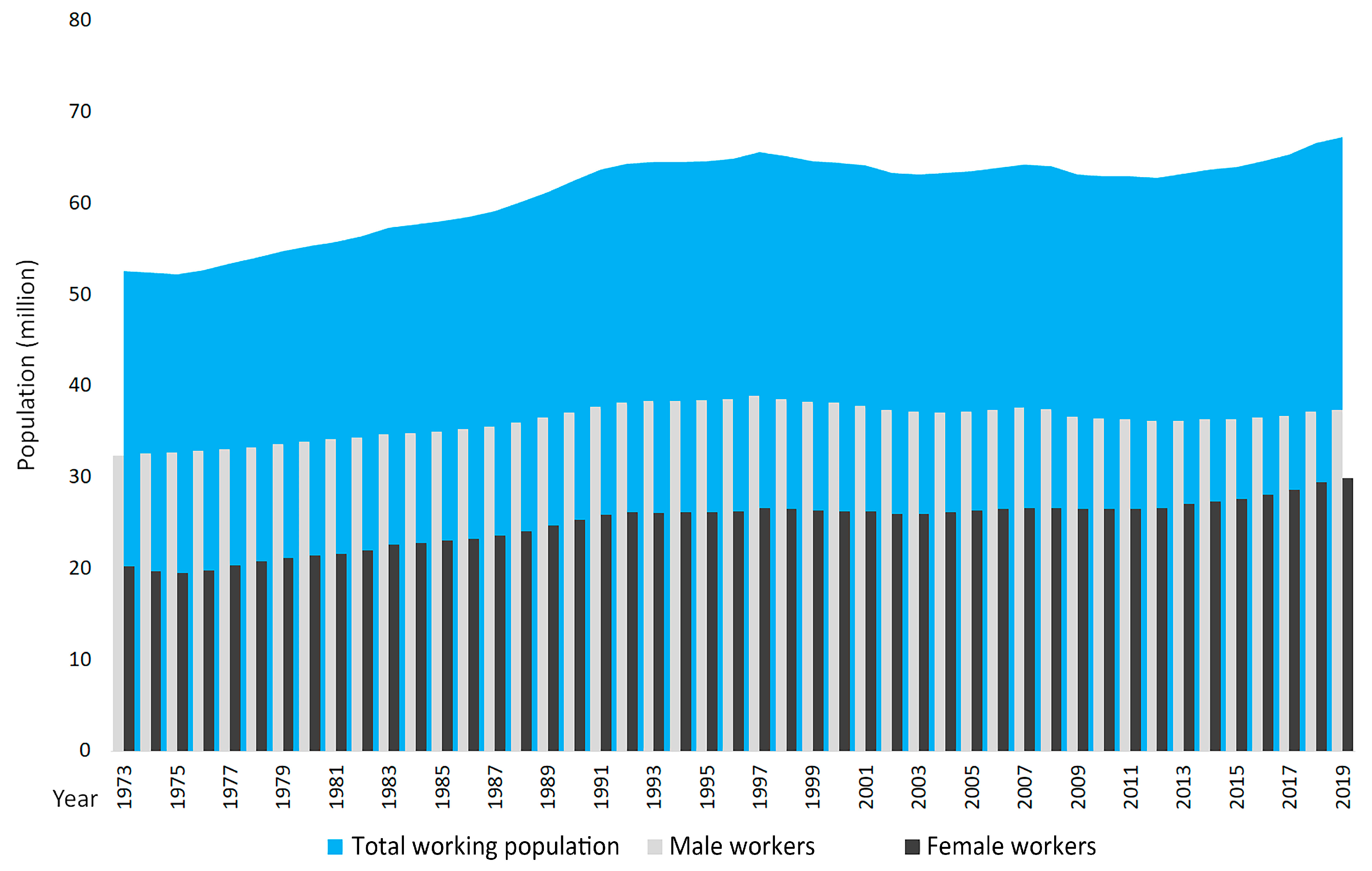
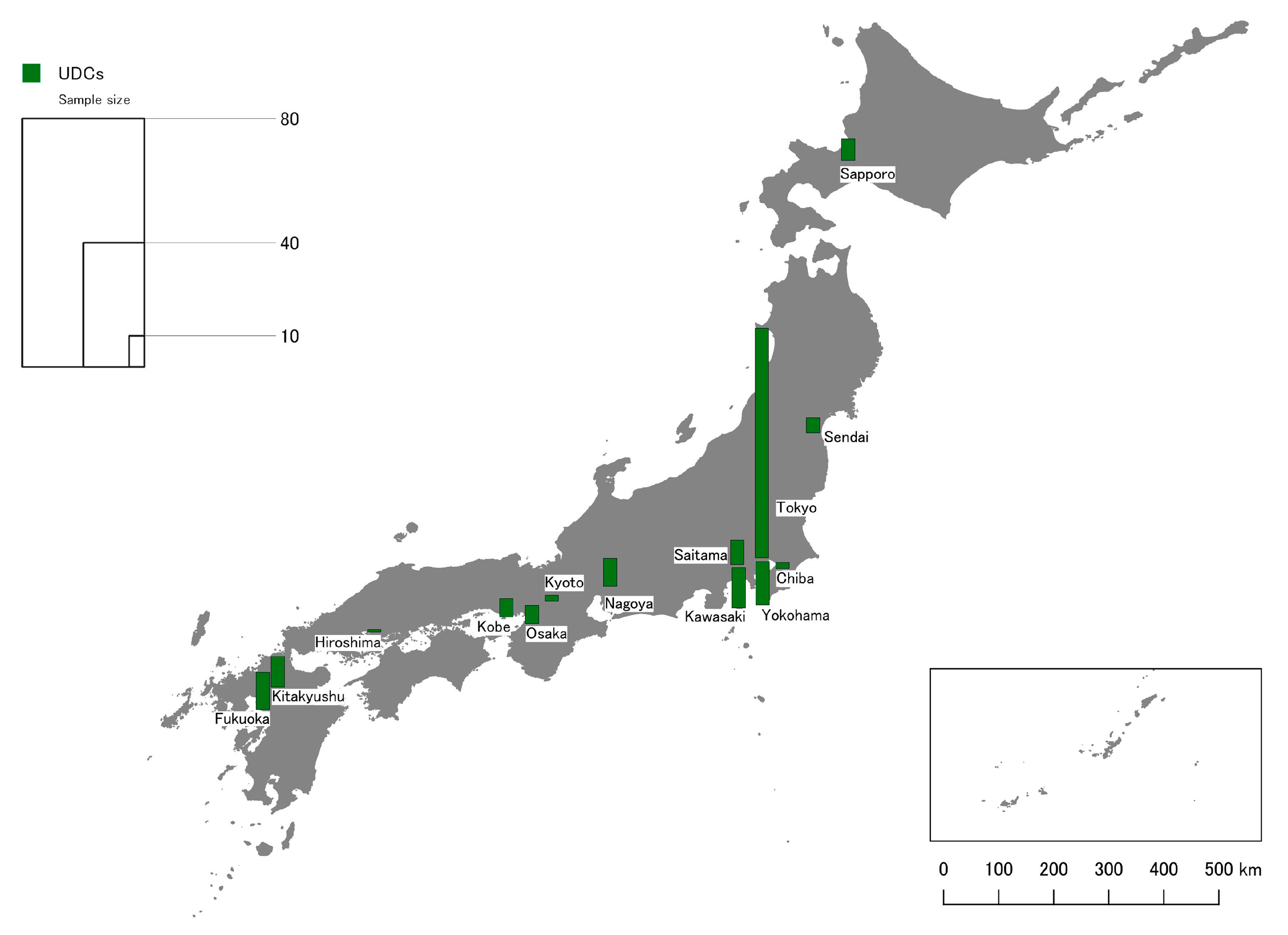
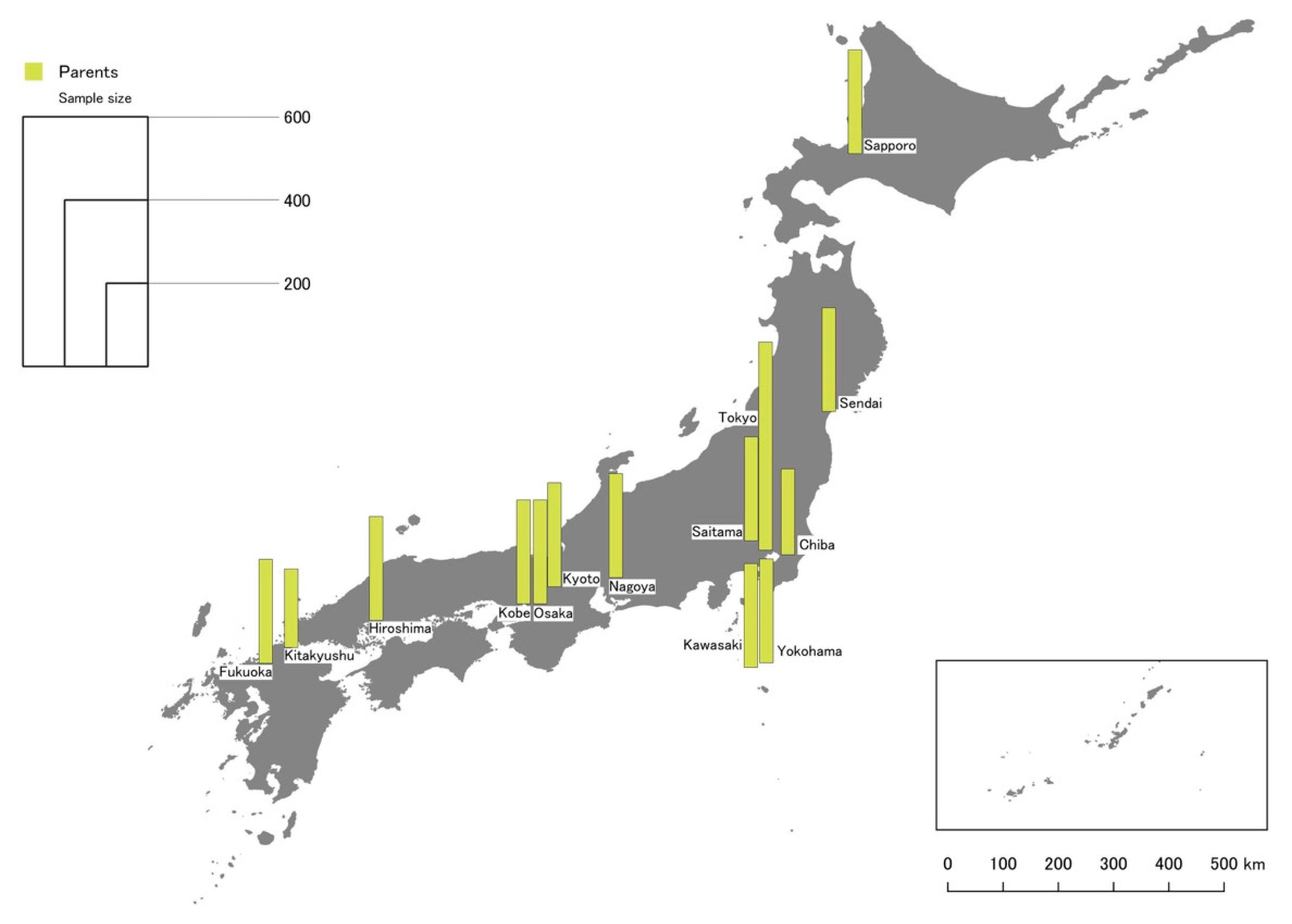

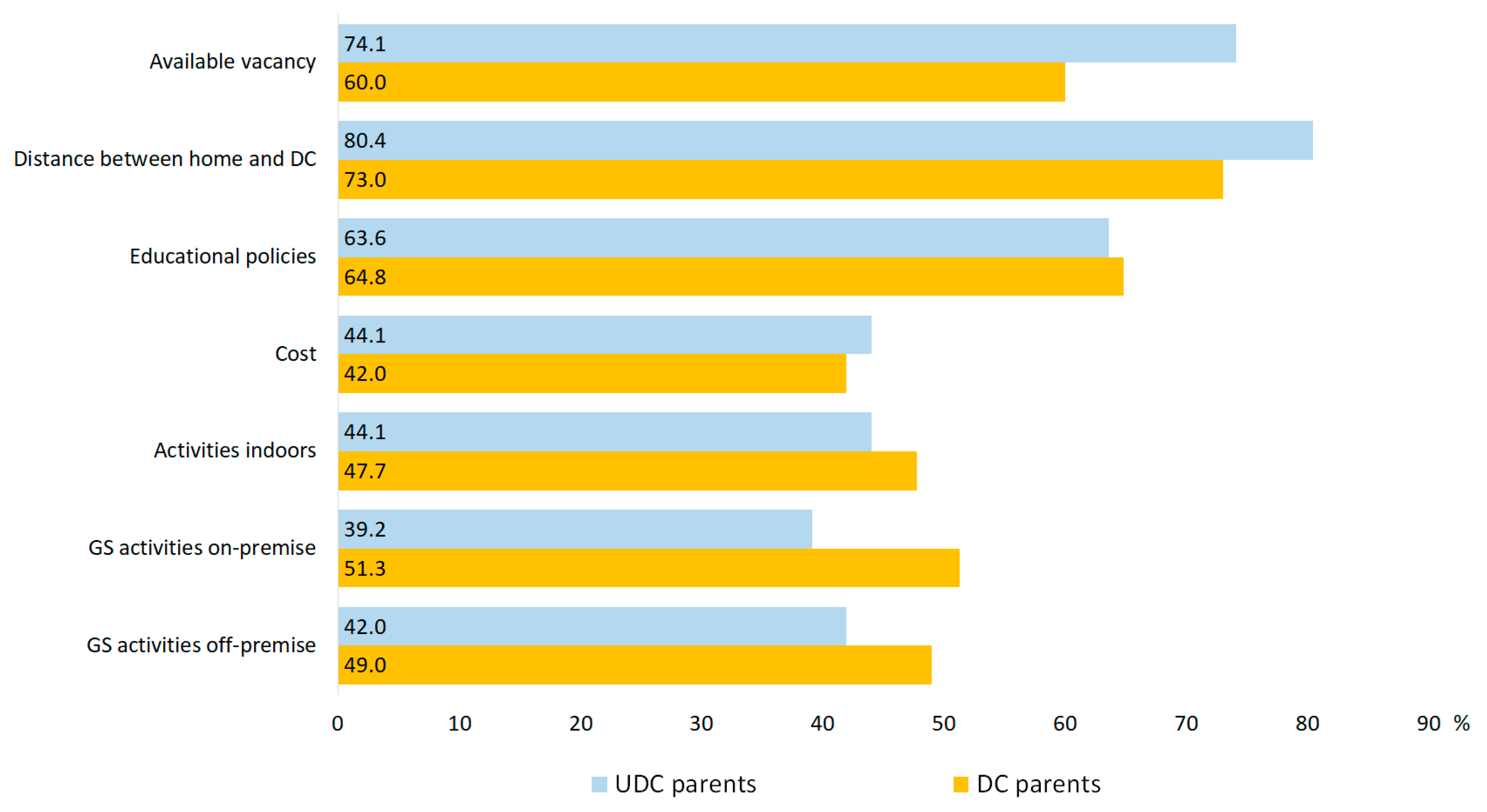
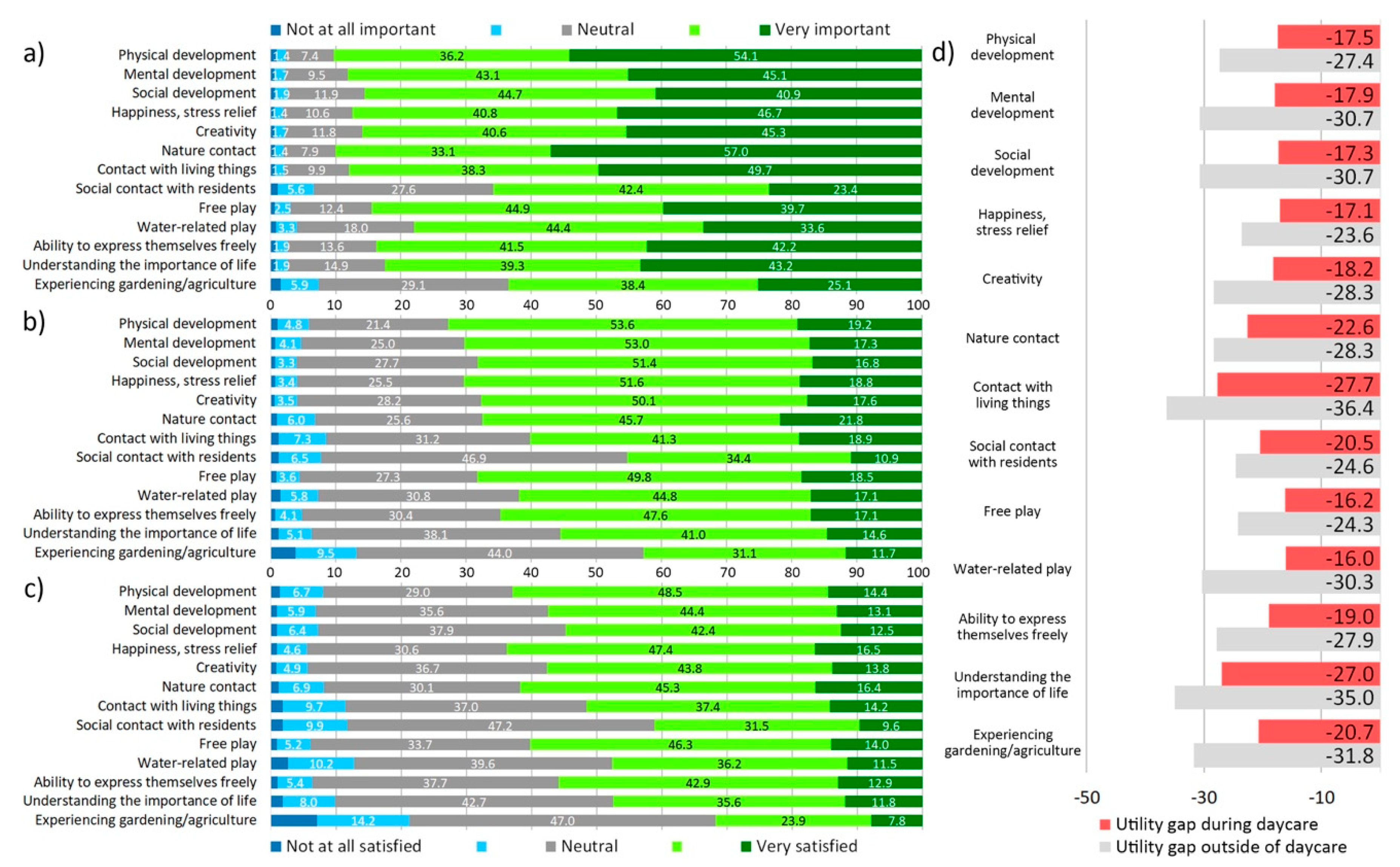
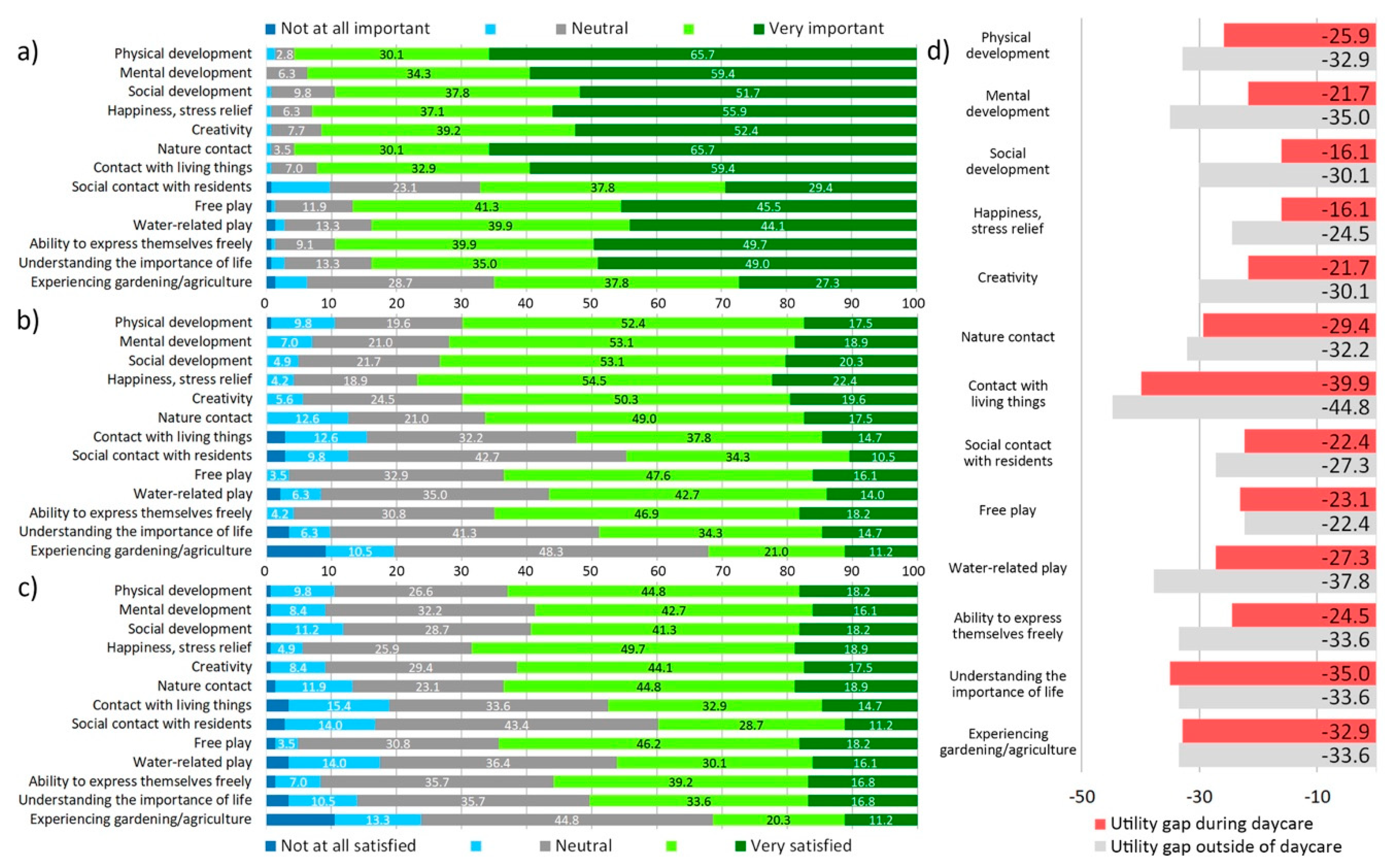
| Characteristics | Licensed Daycare Centers | Tokyo Metropolitan Government Certified Hoikusho | Unlicensed Daycare Centers | ||||
|---|---|---|---|---|---|---|---|
| Subtypes | Hoikusho | Kodomo-en | Yochi-en | Type A | Type B | Baby hotel, nursery center 2 etc. | |
| Ministry in charge 1 | MHLW | MHLW, MEXT | MEXT | Bureau of Social Welfare and Public Health (Tokyo) | Local government | ||
| Legal & regulatory basis | Child Welfare Law | Preschool Childcare Promotion Act 3 | School Education Law | Tokyo Metropolitan Government certified hoikusho implementation guidelines | Unlicensed Daycare center supervision standard, Child Welfare Law | ||
| Catered age | Birth to start of primary school | From age 3 | Birth to start of primary school | Birth to 2 years old | Birth to start of primary school | ||
| Daycare hours | 8 h | 4 h | 13 h | No regulation | |||
| Size | >60 | >35 per grade | >35 per grade | 20~120 (half of children should be aged less than 3) | 6~29 | No regulation | |
| Required facilities | Daycare room, playroom, infant/crawling room, restroom, kitchen, dispensary | Daycare room, playroom, restroom, dispensary, drinking water, washing facilities, staff room | Daycare room, kitchen, restroom, dispensary, etc. | Daycare room, kitchen, restroom | |||
| Maximum child to caregivers ratio | 0 years | 3:1 | 3:1 | 3:1 | 3:1 | ||
| 1 or 2 years | 6:1 | 6:1 | 6:1 | 6:1 | |||
| 3 years | 20:1 | 35:1 short time 20:1 long time | Min. 1 teacher per 1 grade (<35) | 20:1 | 20:1 | ||
| 4+ years | 30:1 | 35:1 short time 30:1 long time | 30:1 | 30:1 | |||
| Minimum daycare room area | 0–1 years | Daycare room: 1.65 m2 per child; Infant/crawling room: 3.3 m2 per child | 3.3 m2 per child | 2.5 m2 per child | 1.65 m2 per child | ||
| 2+ years | 1.98 m2 per child | 1+ room per grade | 1.98 m2 per child | ||||
| Minimum playground area | 3.3 m2 per child aged 2+ (can be substituted by nearby GS) | 3.3 m2 per child aged 2; refer to Yochi-en standard for 3+ years | 2nd + lower grades: 330 + 100 × (grade-1) m2; 3rd + higher grades: 400+80 × (grade-3) m2 | 3.3 m2 per child aged 2+ (can be substituted by nearby GS) | Not required | Not required | |
| Study Site | Population (2015) | Projected Population (2045) | Population Density (2015) | Green Space Per Capita (m2) (2017) | Number of UDCs (2017) |
|---|---|---|---|---|---|
| Tokyo | 13,515,271 | 13,606,683 | 6168.7 | 3.0 | 1300 |
| Yokohama | 3,724,844 | 3,446,124 | 8514.1 | 4.9 | 281 |
| Osaka | 2,691,185 | 2,410,820 | 11,949.7 | 3.5 | 157 |
| Nagoya | 2,295,638 | 2,173,770 | 7032.1 | 7.0 | 108 |
| Sapporo | 1,952,356 | 1,805,120 | 1741.2 | 12.6 | 89 |
| Fukuoka | 1,538,681 | 1,654,572 | 2759.8 | 8.4 | 135 |
| Kobe | 1,537,272 | 1,295,786 | 4480.9 | 17.5 | 63 |
| Kawasaki | 1,475,213 | 1,549,981 | 1782.0 | 3.8 | 173 |
| Kyoto | 1,475,183 | 1,297,241 | 10,316.2 | 4.4 | 37 |
| Saitama | 1,263,979 | 1,285,867 | 5813.3 | 5.1 | 144 |
| Hiroshima | 1,194,034 | 1,122,112 | 1317.1 | 7.8 | 72 |
| Sendai | 1,082,159 | 922,655 | 1376.3 | 15.2 | 81 |
| Chiba | 971,882 | 905,240 | 3576.3 | 9.6 | 38 |
| Kitakyushu | 961,286 | 771,168 | 1954.0 | 12.4 | 54 |
| City | N | Range of Founding Year | Range of Staff No. | Range of Child. No. | Average Staff No. | Average Children No. | Average Student Teacher Ratio | Average Care Time | % With GS |
|---|---|---|---|---|---|---|---|---|---|
| Tokyo | 74 | 1949–2018 | 1–60 | 2–289 | 10.6 | 33.4 | 3.5 | 8.5 | 34.7 |
| Yokohama | 13 | 1983–2015 | 4–20 | 6–69 | 9.1 | 31.1 | 4.1 | 9.3 | 23.1 |
| Osaka | 6 | 1999–2017 | 2–15 | 5–50 | 7.0 | 18.7 | 4.6 | 8.3 | 0.0 |
| Nagoya | 9 | 1924–2016 | 2–23 | 8–200 | 9.0 | 45.3 | 4.5 | 7.3 | 44.4 |
| Sapporo | 7 | 2002–2017 | 3–17 | 10–36 | 8.8 | 22.3 | 2.7 | 9.7 | 50.0 |
| Fukuoka | 12 | 1992–2016 | 4–12 | 18–84 | 7.3 | 34.3 | 5.5 | 9.6 | 41.7 |
| Kobe | 6 | 2003–2017 | 3–35 | 14–25 | 13.7 | 19.4 | 3.2 | 8.5 | 50.0 |
| Kawasaki | 14 | 1993–2015 | 4–25 | 15–89 | 13.0 | 33.8 | 3.2 | 10.0 | 14.3 |
| Kyoto | 2 | 2012–2015 | 3–8 | 6–30 | 5.5 | 18 | 3.08 | 7.75 | 0 |
| Saitama | 8 | 1969–2018 | 3–26 | 10–72 | 14.0 | 39.6 | 2.9 | 10.1 | 62.5 |
| Hiroshima | 1 | 2013 | 4 | 50 | 4.0 | 50.0 | 12.5 | 10.0 | 0.0 |
| Sendai | 5 | 2003–2017 | 4–13 | 10–72 | 7.8 | 33.2 | 4.0 | 7.9 | 20.0 |
| Chiba | 2 | 1994–2001 | 5 | 23–28 | 5.0 | 26.5 | 3.5 | 9.5 | 0 |
| Kitakyushu | 10 | 1996–2017 | 3–18 | 9–54 | 6.3 | 25.8 | 4.9 | 8.1 | 50.0 |
| Total | 169 + 4 1 |
| Practice | Frequency/Time/Type | UDCs (%) |
|---|---|---|
| Frequency of visiting green spaces | Never | 2.3 |
| Less than once a month | 3.5 | |
| 2~3 times a month | 6.4 | |
| Once a week | 4.6 | |
| 2~3 times a week | 19.7 | |
| Everyday | 63.0 | |
| N/A | 0.6 | |
| Frequency of visiting other forms of open spaces (roadsides, commercial settings, etc.) | Never | 61.8 |
| Less than once a month | 9.2 | |
| 2~3 times a month | 7.5 | |
| Once a week | 4.0 | |
| 2~3 times a week | 6.4 | |
| Everyday | 6.9 | |
| N/A | 4.0 | |
| Staying time in green space | Less than 30 min | 6.4 |
| 0.5~1 h | 63.6 | |
| 1~2 h | 16.8 | |
| 2~3 h | 5.8 | |
| More than 3 h | 1.7 | |
| N/A | 5.8 | |
| Types of green space | Parks | 96.0 |
| Riversides | 19.1 | |
| University campuses | 2.3 | |
| Temples and shrines | 24.3 | |
| Farms | 11.0 | |
| Forests | 5.2 | |
| Vacant lots | 4.0 | |
| Others | 23.7 | |
| N/A | 1.7 |
| UDC Attributes | Visit Frequency | Visit Length | Diversity of Spaces Used | Conflict Encountered | Communication with GS Manager/Owner |
|---|---|---|---|---|---|
| Age of facility | X | older = slightly longer | older = slightly higher 1 | X | X |
| Number of staff | X | X | X | X | X |
| Number of children | X | X | X | Medium increase | Small increase |
| Certification | X | X | X | X | X |
| On-premise GS | lower | X | Higher 2 | X | X |
| Affected Item | Attribute | Effect Size | Interpretation |
|---|---|---|---|
| Overall expectations for GS | Age of facility | 0.163 1 | Newer UDCs were slightly more likely to have higher expectations |
| Number of children | −0.151 1 | UDCs with fewer children were slightly more likely to have higher expectations | |
| Visit length | 0.149 1 | Longer visits were weakly correlated with higher expectations | |
| Satisfaction with regularly used GS | Age of facility | −0.185 1 | Newer UDCs were slightly more likely to be less satisfied |
| Visit length | 0.243 1 | Longer visits were weakly correlated with higher satisfaction | |
| Diversity of GS used | 0.153 1 | Higher diversity were weakly correlated with higher satisfaction | |
| On-premise GS | 0.374 2 | UDCs with GS were moderately more likely to be more satisfied | |
| Utility gap between expectations and satisfaction | Age of facility | −0.261 1 | Newer UDCs were slightly more likely to have a larger utility gap |
| On-premise GS | 0.373 2 | UDCs with GS were moderately more likely to have a smaller utility gap | |
| Visit length | 0.251 1 | Longer visits were weakly correlated with a smaller utility gap | |
| Diversity of GS used | −0.177 1 | Lower diversity was weakly correlated with a larger utility gap | |
| Willingness to pay | Staff number | 0.445 2 | Lower staff number was moderately correlated with higher willingness to pay |
| Opening hours | 0.246 2 | Shorter opening hours were weakly correlated with higher willingness to pay | |
| Diversity of GS used | −0.414 2 | Lower diversity was moderately correlated with less willingness to pay | |
| Donation degree | Age of facility | −0.297 1 | Newer UDCs were slightly more likely to be willing to pay a smaller amount |
| Diversity of GS used | 0.211 1 | Higher diversity was weakly correlated with willingness to pay a larger amount |
| Study Site | Number of Samples (N) | Parents with Children in UDCs (%) | Education Undergraduate or Higher (%) | Housing with GS (%) | Mean Age |
|---|---|---|---|---|---|
| Tokyo | 500 | 2.8 | 84.4 | 29.8 | 39.6 |
| Yokohama | 250 | 2.8 | 82.8 | 46.4 | 38.9 |
| Osaka | 250 | 6.0 | 72.8 | 24.0 | 38.3 |
| Nagoya | 250 | 2.8 | 83.2 | 43.2 | 37.8 |
| Sapporo | 250 | 5.6 | 67.6 | 46.0 | 37.8 |
| Fukuoka | 250 | 4.2 | 74.0 | 30.8 | 37.4 |
| Kobe | 250 | 4.8 | 75.6 | 50.0 | 37.6 |
| Kawasaki | 250 | 4.4 | 85.6 | 38.4 | 38 |
| Kyoto | 250 | 3.6 | 77.6 | 33.2 | 37.9 |
| Saitama | 250 | 4.4 | 83.2 | 48.8 | 38 |
| Hiroshima | 250 | 3.6 | 79.2 | 44.4 | 37.1 |
| Sendai | 250 | 4.8 | 71.2 | 49.6 | 37.1 |
| Chiba | 206 | 1.0 | 83.0 | 62.6 | 38.4 |
| Kitakyushu | 189 | 3.7 | 64.6 | 46.6 | 37.1 |
| Aspect of Perception | Factors | Effect Size | Interpretation |
|---|---|---|---|
| Satisfaction with green space access during daycare | City | 0.013 1 | Parents from Tokyo, Osaka and Nagoya are less satisfied; Parents from Sapporo, Kitakyushu, and Kyoto are more satisfied |
| Education | −0.05 2 | Educational attainment was weakly correlated with lower satisfaction | |
| Income | −0.037 2 | Income was weakly correlated with lower satisfaction | |
| Frequency of GS visits by caregivers | 0.039 2 | Lower frequency was weakly correlated with lower satisfaction | |
| Gender | −0.229 3 | Men were slightly less likely to be satisfied | |
| Age | −0.057 2 | Age was weakly correlated with lower satisfaction | |
| Having GS in facilities | 0.219 3 | Parents with children in daycare without on-premise GS were less likely to be satisfied | |
| Utility gap | Gender | 0.146 3 | Men had on average a larger utility gap |
| Having GS in facilities | 0.159 3 | Parents of children in daycare centers without on-premise GS had a larger utility gap | |
| License | 0.288 3 | Unlicensed daycare centers had a larger utility gap | |
| Frequency of GS visits by caregivers | 0.039 2 | Frequency was weakly correlated with a smaller utility gap | |
| Amount of donation | Income | 0.057 2 | Income was weakly correlated with higher donation amounts |
| Frequency of GS visiting by care-givers | −0.068 2 | Frequency was weakly correlated with lower donation amounts | |
| Gender | 7.61 1 | Women reported on average lower donation amounts | |
| Having GS in facilities | 8.57 1 | Parents of children in daycare centers without on-premise GS reported on average lower donation amounts |
© 2020 by the authors. Licensee MDPI, Basel, Switzerland. This article is an open access article distributed under the terms and conditions of the Creative Commons Attribution (CC BY) license (http://creativecommons.org/licenses/by/4.0/).
Share and Cite
Rupprecht, C.D.D.; Cui, L. Understanding Threats to Young Children’s Green Space Access in Unlicensed Daycare Centers in Japan. Int. J. Environ. Res. Public Health 2020, 17, 1948. https://doi.org/10.3390/ijerph17061948
Rupprecht CDD, Cui L. Understanding Threats to Young Children’s Green Space Access in Unlicensed Daycare Centers in Japan. International Journal of Environmental Research and Public Health. 2020; 17(6):1948. https://doi.org/10.3390/ijerph17061948
Chicago/Turabian StyleRupprecht, Christoph D. D., and Lihua Cui. 2020. "Understanding Threats to Young Children’s Green Space Access in Unlicensed Daycare Centers in Japan" International Journal of Environmental Research and Public Health 17, no. 6: 1948. https://doi.org/10.3390/ijerph17061948
APA StyleRupprecht, C. D. D., & Cui, L. (2020). Understanding Threats to Young Children’s Green Space Access in Unlicensed Daycare Centers in Japan. International Journal of Environmental Research and Public Health, 17(6), 1948. https://doi.org/10.3390/ijerph17061948






